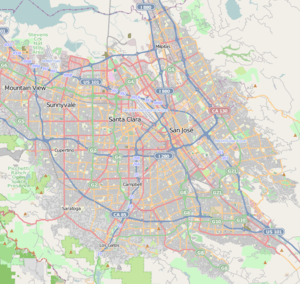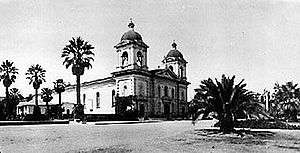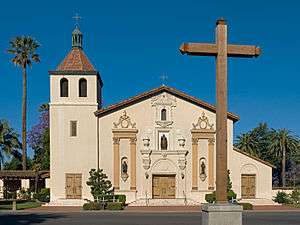Mission Santa Clara de Asís
|
Mission Santa Clara | |
 Location in the Santa Clara Valley | |
| Location |
500 El Camino Real Santa Clara, California 95053 |
|---|---|
| Coordinates | 37°20′57″N 121°56′30″W / 37.349269°N 121.9416°WCoordinates: 37°20′57″N 121°56′30″W / 37.349269°N 121.9416°W |
| Name as founded | La Misión Santa Clara de Asís [1] |
| English translation | The Mission of Saint Clare of Assisi |
| Founding date | January 12, 1777 [2] |
| Founding priest(s) | Father Presidente Junípero Serra [3][4] |
| Founding Order | Eighth[5] |
| Military district | Fourth[6] |
| Native tribe(s) Spanish name(s) |
Bay Miwok, Tamyen, Yokuts Costeño |
| Native place name(s) | Socoisuka [7] |
| Baptisms | 8,536[8] |
| Marriages | 2,498[8] |
| Burials | 6,809[8] |
| Neophyte population | 1,125[9] |
| Secularized | 1836[5] |
| Governing body | Santa Clara University; Roman Catholic Diocese of San Jose |
| Current use | University chapel; Parish church |
| Reference no. | #338 |
| Website | |
|
www | |
Mission Santa Clara de Asís is a Spanish mission founded by the Franciscan order in the present-day city of Santa Clara, California. The mission, the eighth in California, was founded on January 12, 1777 and named for Saint Clare of Assisi, the foundress of the order of the Poor Clares. It is the namesake of both the city and county of Santa Clara, as well as Santa Clara University, which was built around the mission. This was the first California mission to be named in honor of a woman and the only one now located on a university campus.
Although ruined and rebuilt six times, the settlement was never abandoned,[10] and today it functions as both a parish church of the Diocese of San Jose and a university chapel for Santa Clara University.
History
The outpost was originally established as La Misión Santa Clara de Thamien (or Mission Santa Clara de Thamien, a reference to the Tamyen people) at the Indian village of So-co-is-u-ka (meaning "Laurelwood", located on the Guadalupe River) January 12, 1777. There the Franciscan brothers erected a cross and shelter for worship to bring Christianity to the Ohlone and Costanoan peoples. Floods, fires, and earthquakes damaged many of the early structures and forced relocation to higher ground. The second site is known as Mission Santa Clara de Asís. A subsequent site of the mission dating from 1784 to 1819 is located several hundred yards west of the De La Cruz overpass of the Caltrain track; moreover, several Native American burial sites have been discovered near this subsequent site.[11] The current site, home to the first college in Alta California, dates back to 1828.[3]
Initially, there was tension between the people of the mission and those in the nearby Pueblo de San Jose over disputed ownership rights of land and water. The tension was relieved when a road, the Alameda, was built by two hundred Indians to link the communities together.[12] On Sundays, people from San Jose would come to the mission for services, until the building of St. Joseph's Church in 1803. In that year, the mission of Santa Clara reported an Indian population of 1,271. In the same tabular report, its resident priest estimated that 10,000 cattle, 9,500 sheep, 730 horses, 35 mules, and 55 swine were on mission lands, while about 3,000 fanegas of grain (some 220 pounds each of wheat, barley or corn) had been harvested.
After the Mexican secularization act of 1833 most of the mission's land and livestock was sold off by Mexico. Most of the buildings continued to be used as a parish church, unlike the other missions in California.[13]
In 1850, California became a state, with that change priests of the Jesuit Order took over the Mission Santa Clara de Asís in 1851 from the Franciscans. Father John Nobili, S.J., was put in charge of the mission. He began a college on the mission site in 1851, which grew into Santa Clara University;[14] it is the only mission to become part of a university, and it is also the oldest university in California. Throughout the history of the mission, the bells have rung faithfully every evening, a promise made to King Charles III of Spain when he sent the original bells to the mission in 1777. He asked that the bells be rung each evening at 8:30 in memory of those who had died.
In 1861, a new wooden façade with two bell towers was attached over the old adobe front of the building. The interior was widened in 1885 to increase the seating capacity by removing the original adobe nave walls.[15][16] A fire in 1925 destroyed the structure, including the surrounding wall. The church's parochial functions were transferred to the Saint Clare Parish west of the campus. A rebuilt and restored Mission Santa Clara was consecrated in 1929, when it assumed its primary modern function as chapel and centerpiece of the university campus. It is open to visitors every day; the mission museum is located in the university's De Saisset Museum.
The original mission cemetery, still used, is located on nearby Lincoln Street.[17][18]
Other historic designations
- California Historical Landmark No. 250 – Old sites of Mission Santa Clara de Thamien and the Old Spanish Bridge
See also
| Wikimedia Commons has media related to Mission Santa Clara de Asís. |
- USNS Mission Santa Clara (AO-132) – a Buenaventura Class fleet oiler built during World War II.
Notes

- ↑ Leffingwell, p. 137
- ↑ Yenne, p. 80
- 1 2 Ruscin, p. 196.
- ↑ Leffingwell, p. 137. Though Serra is generally credited with the Mission's founding, it was Father Tomás de la Peña who actually celebrated the first mass at the site.
- 1 2 Krell, p. 167
- ↑ Forbes, p. 202
- ↑ Ruscin, p. 195
- 1 2 3 Krell, p. 315: as of December 31, 1832; information adapted from Engelhardt's Missions and Missionaries of California. Mission Santa Clara witnessed the greatest number of baptisms, marriages, and burials of any settlement in the Alta California chain.
- ↑ Krell, p. 315: as of December 31, 1832; information adapted from Engelhardt's Missions and Missionaries of California.
- ↑ Ruscin, p. 79
- ↑ Giglio, p. 3.11-1
- ↑ Shannon E. Clark, The Alameda: The Beautiful Way, San Jose: Alameda Business Association, 2006, ISBN 978-1-4243-1868-1, p. 2.
- ↑ Santa Clara University, History of Mission Santa Clara de Asis, By Teresa Pugh
- ↑ Fodor's (December 21, 2010). Fodor's Northern California 2011: With Napa, Sonoma, Yosemite, San Francisco & Lake Tahoe. Random House Digital, Inc. p. 48. ISBN 978-1-4000-0503-1. Retrieved December 25, 2011.
- ↑ Pugh, Teresa (2006). "History of Mission Santa Clara de Asis". Santa Clara University. Retrieved 2013-06-08.
- ↑ Kimbro, Edna; Costello, Julia G.; Ball, Tevvy (October 20, 2009). The California Missions: History, Art and Preservation. Getty Conservation Institute. ISBN 0-89236-983-3.
- ↑ Lichtenstein, Bea (2005). "Images of America Series". Cemeteries of Santa Clara. Mount Pleasant, South Carolina: Arcadia Publishing. ISBN 9780738530130.
- ↑ Santa Clara Mission Cemetery. Santa Clara University
References

- Forbes, Alexander (1839). California: A History of Upper and Lower California. Smith, Elder and Co., Cornhill, London.
- Giglio, Gary, C., et al. Environmental Impact Report for the General Plan Amendment, Rezoning and Development of a Portion of FMC Corporation's Coleman Avenue Facility, Earth Metrics Inc., September 1988, published by the City of Santa Clara, California.
- Jones, Terry L. and Kathryn A. Klar (eds.) (2007). California Prehistory: Colonization, Culture, and Complexity. Altimira Press, Landham, MD. ISBN 0-7591-0872-2.
- Leffingwell, Randy (2005). California Missions and Presidios : The History & Beauty of the Spanish Missions. Voyageur Press, Inc., Stillwater, MN. ISBN 0-89658-492-5. line feed character in
|title=at position 34 (help) - Levy, Richard. (1978). William C. sturrent , and Robert F. Heizer, ed. Handbook of North American Indians. 8 (California). Smithsonian Institution, Washington, DC. p. 486. ISBN 0-87474-188-2.
- Milliken, Randall (1995). A Time of Little Choice: The Disintegration of Tribal Culture in the San Francisco Bay Area 1769–1910. Ballena Press Publication, Menlo Park, CA. ISBN 0-87919-132-5.
- Paddison, Joshua (ed.) (1999). A World Transformed: Firsthand Accounts of California Before the Gold Rush. Heyday Books, Berkeley, CA. ISBN 1-890771-13-9.
- Ruscin, Terry (1999). Mission Memoirs. Sunbelt Publications, San Diego, CA. ISBN 0-932653-30-8.
- Yenne, Bill (2004). The Missions of California. Advantage Publishers Group, San Diego, CA. ISBN 1-59223-319-8.
External links
- Early photographs, sketches of Mission Santa Clara de Asís, via Calisphere, California Digital Library
- Howser, Huell (December 8, 2000). "California Missions (106)". California Missions. Chapman University Huell Howser Archive.
